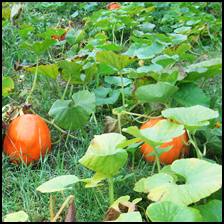
Pumpkin
SCIENTIFIC NAME:(Cucurbita pepo)
Being an annual, herbaceous plant, cultivated for its fruit, flowers and seeds, pumpkin has a flexible and climbing stem. Its leaves are big, heart shaped, with well marked nerves. Its flowers are yellow and pulpy. The fruit can be oval or spherical, of a green or intense orange color. The fruit’s pulp is of a yellowish-orange color, dense with a sweet taste.
Pumpkin is rich in anti-oxidants and beta-carotene. Beta-carotene is a vitamin that can be converted by the body into vitamin A. This helps the body in its process of regeneration, slowing down the aging process. Pumpkin pulp contains vitamins, especially pro-vitamin A, vitamins E and C, salts and minerals, carbon hydrates, and proteins. The seeds contain oil, proteins and enzymes with anti-oxidant properties. The pumpkin’s core contains lecithin, tyrosine, phosphorus and vitamins B and A.
Common Names:

Uses:
Pumpkin seeds contain the strongest therapeutic effects. These help in eliminating intestinal parasites, cleaning blood vessels, adjusting cholesterol level and stimulating kidney activity. The seeds have an energizing effect on those undergoing treatments for cancer and leukemia as well as other diseases.Pumpkin oil extracted from the seeds is recommended for reducing excess cholesterol. Pumpkin offers protection against heart diseases by containing antioxidants.
The vegetable has a laxative action, being useful in case of dyspepsia and constipation. Fried pumpkin is healthy for those who suffer from heart diseases.
Pumpkin juice is indicated for ulcer and high acidity. It has to be drunk three times a day, half an hour before meals. It is also useful in cases of insomnia, having sedative properties.
Pumpkin is also indicated in cases of hormonal disorders or adolescent behavior, menopause disorder, intestinal parasites or sexual hyper-excitability. In external use, pumpkin is recommended for treating burns, inflammations and abscesses. It softens the skin and diminishes the inflammatory processes of mucous.
Pumpkin can be eaten either fried or under the form of a pie, raw and shaven in tomato, pickle or cauliflower salads or in soups. Before preparing them for food, pumpkins have to be cut and cleared of seeds. If fried, before inserting them into the hot oven, they can be anointed with olive oil, salt and pepper. They can be filled with cheese paste or rice and mushrooms.
Pumpkin leaves can be used to reduce fever. Pumpkin juice is used in treating cancer and vascular diseases.
Use the pulp of the fruit as a facial and benefit from its hydrating effects.
Applications:
Decoction:
Boil a handful of leaves in 6 cups of water for 10 minutes; steep for 30 minutes and then strain. Drink 4 cups a day until fever breaks.
Eating:
Eat as a fruit or vegetable. Roast and shell seeds before eating.






